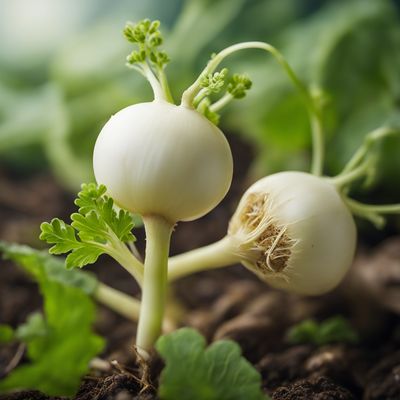
Ingredient
Burnet saxifrage roots
Burnet Saxifrage: A Hidden Gem of Culinary Delights
Burnet saxifrage roots are slender, pale roots that have a crisp texture and a subtle, herbaceous flavor. They are often compared to carrots or parsnips but with a milder taste. The roots have a pale yellow color and a cylindrical shape, making them visually appealing when used in dishes. Their delicate flavor pairs well with a variety of ingredients and can be enjoyed both raw and cooked.
Origins and history
Burnet saxifrage has a long history of culinary use, particularly in European cuisines. It has been cultivated for centuries and was highly regarded for its medicinal properties in ancient times. The roots were traditionally used as a digestive aid and to add flavor to dishes. Today, burnet saxifrage is still appreciated for its unique taste and is often used in salads, soups, and as a garnish for various dishes.
Nutritional information
Burnet saxifrage roots are low in calories and fat, making them a healthy addition to your diet. They are a good source of dietary fiber and contain essential vitamins and minerals, including vitamin C and potassium.
Allergens
May cause allergic reactions in individuals with celery or carrot allergies.
How to select
When selecting burnet saxifrage roots, look for roots that are firm and free from blemishes or soft spots. The roots should have a fresh, earthy aroma. Avoid roots that appear wilted or discolored. Opt for smaller roots, as they tend to be more tender and flavorful.
Storage recommendations
To maintain the freshness of burnet saxifrage roots, remove any excess soil and store them in a perforated plastic bag in the refrigerator. They can stay fresh for up to two weeks. Before using, rinse the roots thoroughly under cold water to remove any dirt or debris.
How to produce
Burnet saxifrage can be grown in home gardens or containers. It prefers well-drained soil and partial shade. Sow the seeds in early spring or late summer and keep the soil consistently moist. Harvest the roots when they reach a desirable size, usually after 90 to 120 days.
Preparation tips
Burnet saxifrage roots can be enjoyed raw in salads, providing a crunchy texture and a mild, refreshing flavor. They can also be cooked by boiling, steaming, or roasting, which brings out their natural sweetness. Add them to soups, stews, or stir-fries for an extra layer of flavor and texture. Additionally, the roots can be pickled or used as a garnish for cocktails or appetizers.
Culinary uses
Burnet saxifrage roots are commonly used in salads, both as a main ingredient and as a garnish. They add a refreshing crunch and a subtle herbaceous flavor to green salads, grain salads, and even fruit salads. The roots can also be used in soups, stews, and stir-fries to enhance the overall taste and texture of the dish.
Availability
Burnet saxifrage roots are native to Europe and can be found growing wild in certain regions. They are also cultivated in home gardens and are occasionally available at farmers markets or specialty grocery stores.

